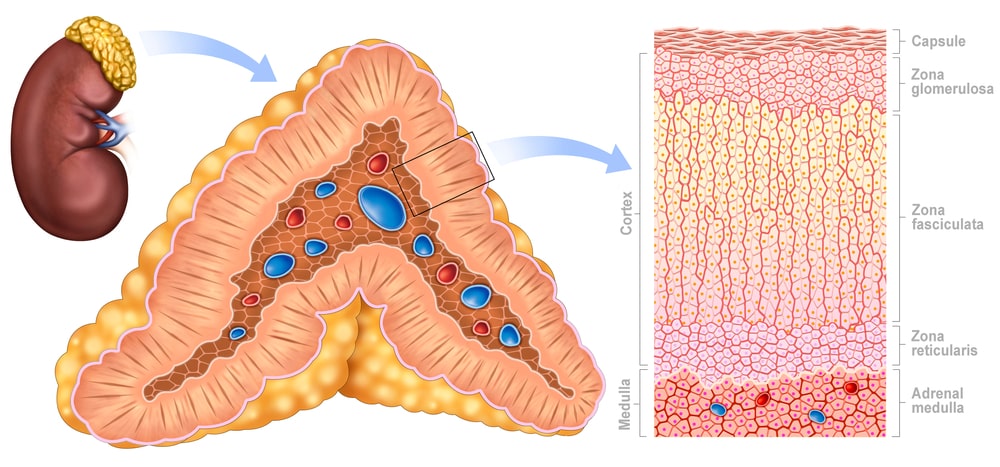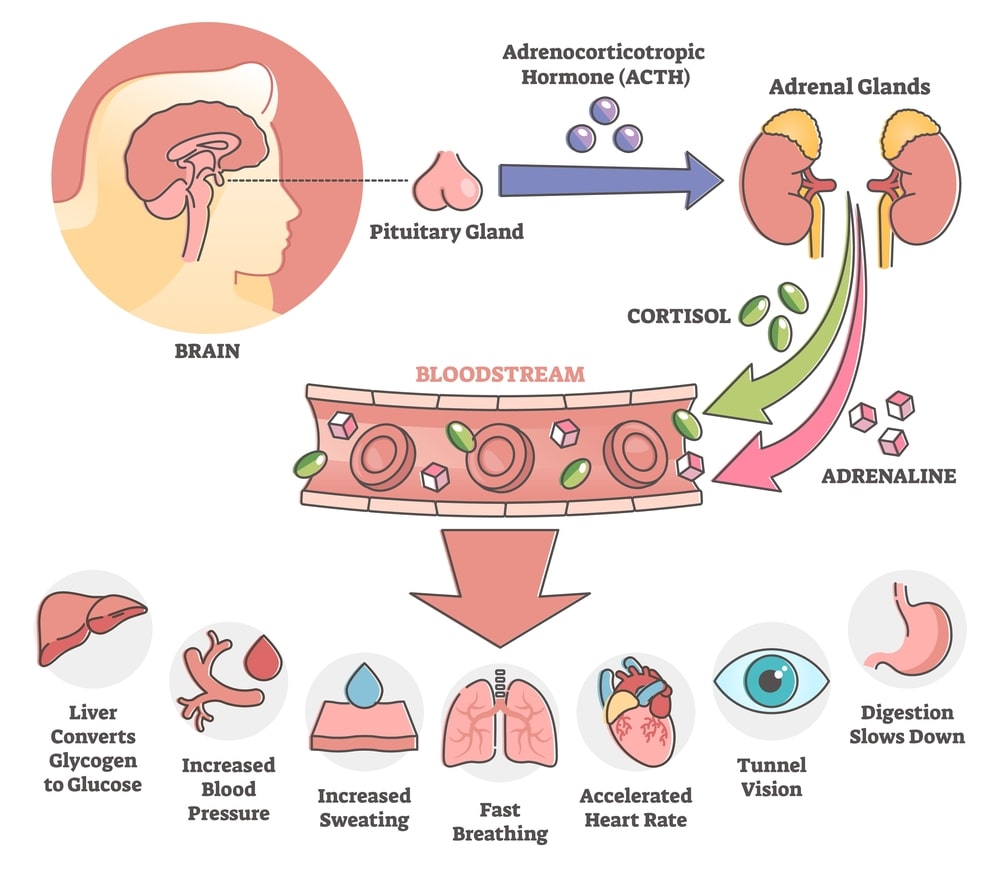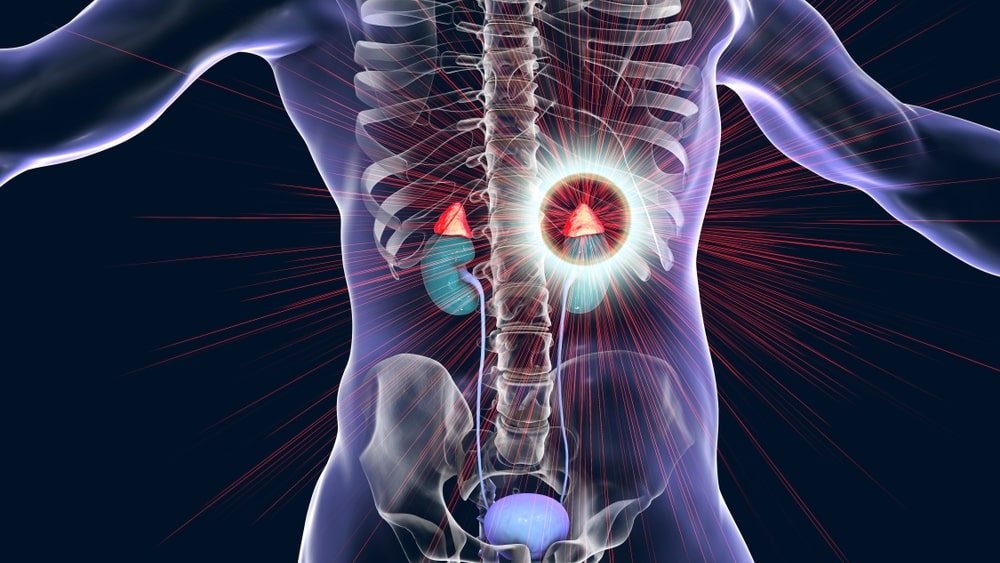The two adrenal glands (suprarenal) are situated on the upper pole of each kidney enclosed within the renal fascia. They are about 4 cm long and 3 cm thick. The arterial blood supply to the glands is by branches from the abdominal aorta and renal arteries.
The venous return is by suprarenal veins. The right gland drains into the inferior vena cava and the left into the left renal vein. The glands are composed of two parts that have different structures and functions. The outer part is the cortex and the inner part is the medulla. The adrenal cortex is essential to life but the medulla is not.

Table of Contents
Adrenal cortex
Embryologically, it is developed from mesoderm. It secretes the steroid hormones that are essential for life. The removal of the adrenal cortex leads rapidly to death within a week. This is mainly because of a deficiency of aldosterone, a hormone that regulates blood sodium (Na+) levels. Loss of Na+ leads to hypotensive shock and death. A group of steroid hormones secreted by the adrenal cortex is called as corticosteroids. These include mainly two types, the mineral corticoids, and glucocorticoids. In addition, it also secretes small quantities of androgenic and estrogenic hormones.
Mineral corticoids
The mineral corticoids, mainly aldosterone, regulate electrolyte (Na+, K+) levels and hence water (fluid) balances of the body. Aldosterone functions at renal tubules and enhances the reabsorption of Nat. The reabsorption of Nat is followed by the reabsorption of water. At the same time, it promotes the loss of K+ and H+ in the urine. The secretion of aldosterone is increased by several mechanisms. An increase in potassium (K+) in tissue fluid, decrease in sodium (Na+) in tissue fluid directly stimulate the adrenal cortex to secrete aldosterone. The formation of angiotensin stimulates the secretion of aldosterone. A decrease in blood volume due to any reason results in a decrease in blood pressure. The Juxtaglomerular cells in kidneys respond to this decrease in blood pressure by secreting enzyme rennin into the blood. Renin converts angiotensin, a plasma protein into angiotensin-I. While the blood flows through the lungs angiotensin-I is converted into angiotensin-II. Angiotensin-II stimulates the adrenal cortex to secrete aldosterone.
Glucocorticoids
The hormones chiefly affecting the metabolism of carbohydrates, proteins and fats are glucocorticoids; and include cortisol (hydrocortisone), corticosterone, and cortisone. Of the three hormones, the cortisol is most abundant and responsible for glucocorticoids activity.
- Effects on carbohydrate metabolism: Glucocorticoids promote gluconeogenesis (formation of glucose by non-carbohydrate sources). They inhibit the utilization of glucose by peripheral tissues. This results in the rise of blood glucose levels.
- Effects on protein metabolism: They reduce protein stores by decreasing protein anabolism and mobilization of amino acids from the tissues. The permeability of liver cells to amino acids is increased.
- Effect on fat metabolism: According to the need of the body, the glucocorticoids either promote fat mobilization from fat depots or increase the rate of fat deposition as adipose tissue.
Glucocorticoids also affect lymphoid tissue and reduce the number of circulating eosinophils. Large doses of administered glucocorticoids may completely block the formation of antibodies.
Gonad Hormones
The hormones secreted by the adrenal cortex having an influence on sex organs include androgen, estrogen, and progestin. The amount of sex hormones secreted by adult male adrenals is usually so low that their effects are insignificant. In females, adrenal androgens contribute to sex drive (libido).
Adrenocortical Disorders
The hyposecretion results in Addison’s disease characterized by muscular weakness, gastrointestinal disturbances, decreased plasma volume, low blood pressure, weight loss, loss of appetite, and diminished ability to withstand stress.
Hypersecretion may result in a number of disorders. It produces Cushing’s syndrome which is characterized by adipose tissue accumulation with weight gain, weakness, hypertension, diabetes, and hirsutism. Certain adrenal tumors may produce iridizing or feminizing effects as a result of the production of androgenic or estrogenic compounds.
Adrenal Medulla
Embryologically, the adrenal medulla is developed from neural crest cells. It functions in a manner similar to postganglionic sympathetic nerve cells, and hence, may be regarded as a modified sympathetic ganglion.
Adrenal Medullary Hormones
It secretes two hormones, both having a catechol nucleus and amino group. These hormones are called epinephrine (Adrenaline) and nor-epinephrine (Nor-adrenaline). The physiological effects of these hormones are the same as that of the sympathetic nervous system; hence these are also called sympathomimetic amines. They show the effect on the organs which are innervated by sympathetic nerves. Although they have structural similarities, except few common effects, their functions are different. Epinephrine exerts metabolic as well as cardiovascular effects. Nor-epinephrine exerts effects primarily on the vascular system. In addition to being secreted as neither hormone, nor-epinephrine it is also released as a neurohumoral transmitter at end terminals of postganglionic sympathetic neurons.
Noradrenaline is the postganglionic neurotransmitter of the sympathetic division of the autonomic nervous system) Adrenaline and some noradrenaline are released into the blood from the adrenal medulla during stimulation of the sympathetic nervous system. The action of these hormones prolongs and augments the stimulation of the sympathetic nervous system. They are structurally very similar and this explains their similar effects. Together they potentiate the fight or flight response by:
- Increasing heart rate
- Increasing blood pressure
- diverting blood to essential organs, including the heart, brain, and skeletal muscles, by dilating their blood vessels and constricting those of less essential organs, such as the skin
- increasing metabolic rate
- dilating the pupils.
Adrenaline has a greater effect on the heart and metabolic processes whereas noradrenaline has more influence on blood vessels.
Response to stress
When the body is under stress homeostasis is disturbed. To restore it and, in some cases, to maintain life there are immediate and, if necessary, longer-term responses. Stressors include exercise, fasting, fright, temperature changes, infection, disease, and emotional situations.
The immediate response is sometimes described as preparing for ‘fight or flight’. This is mediated by the sympathetic part of the autonomic nervous system and the principal effects are shown in Figure 1.2.

In the longer term, ACTH from the anterior pituitary stimulates the release of glucocorticoids and mineralocorticoids from the adrenal cortex and a more prolonged response to stress occurs.
Make sure you also check our other amazing Article on: Types of Hypertension
